DC-3 Cowl Flaps ?
Thread Starter
Join Date: Oct 2007
Location: Dr. Evil's secret volcano lair
Posts: 147
Likes: 0
Received 0 Likes
on
0 Posts
DC-3 Cowl Flaps ?
Does anyone know why some DC-3s/C-47s don't have, or have fixed cowl flaps ? All the DC3s here in NZ (pratt powered) that I know of don't have them, yet in the in the flight manual it talks about them (part of the hydraulic system) and all the ones I've seen in other countries and in all photos seem to have them.
Must be a mod yet I've no info on this. Anyone know the details, reason why etc ??
Cheers.
Must be a mod yet I've no info on this. Anyone know the details, reason why etc ??
Cheers.
Join Date: Jul 1999
Location: Out of a Suitcase
Posts: 155
Likes: 0
Received 0 Likes
on
0 Posts
All the DC-3's I flew were modified C-47's
Cowl flaps had 3 positions Open/Trail/Close
Open position on the ground for maximum heat dissipation.
Close in cruise if I remember correctly (also if the engines were going to be covered by engine covers after parking).
Trail was set prior to take-off/landing where the airflow would regulate the position of the cowl flaps - at higher forward speed they tended to the closed position and at lower speeds they tended to the open position.
This prevents cylinder head temperatures from getting too high.
Cowl flaps had 3 positions Open/Trail/Close
Open position on the ground for maximum heat dissipation.
Close in cruise if I remember correctly (also if the engines were going to be covered by engine covers after parking).
Trail was set prior to take-off/landing where the airflow would regulate the position of the cowl flaps - at higher forward speed they tended to the closed position and at lower speeds they tended to the open position.
This prevents cylinder head temperatures from getting too high.
DC-3 cowl flaps are hydraulic, and pretty much useless. There's one actuator per engine and when it extends a ring of linkages expands, pushing the cowl flaps open. When it retracts, it pulls the linkages tighter and the cowl flaps close. If there is any play in the linkages, the slop in the system takes up the motion before the cowl flaps move. Or the other way, if there is a load on the cowl flaps, they'll use that play to move to where they want.
I've heard of a mod to just fix panels around the cowl and leave a small gap for airflow but I've never flown one with that mod. I pulled upsome NZ DC-3 photos on airliners, some do have cowl flaps but ZK-DAK has panels riveted in place.
I've heard of a mod to just fix panels around the cowl and leave a small gap for airflow but I've never flown one with that mod. I pulled upsome NZ DC-3 photos on airliners, some do have cowl flaps but ZK-DAK has panels riveted in place.
Join Date: May 2008
Location: Scotland
Age: 80
Posts: 451
Likes: 0
Received 0 Likes
on
0 Posts
The dc3s operated by Malayan Airways in the 50's had fixed cowlings - due to the high ambient temperatures in the area movable cowl flaps would have rarely been closed. I will try to find photographs that I took as a boy.
Thread Starter
Join Date: Oct 2007
Location: Dr. Evil's secret volcano lair
Posts: 147
Likes: 0
Received 0 Likes
on
0 Posts
The dc3s operated by Malayan Airways in the 50's had fixed cowlings - due to the high ambient temperatures in the area movable cowl flaps would have rarely been closed. I will try to find photographs that I took as a boy.
Here are some old photos
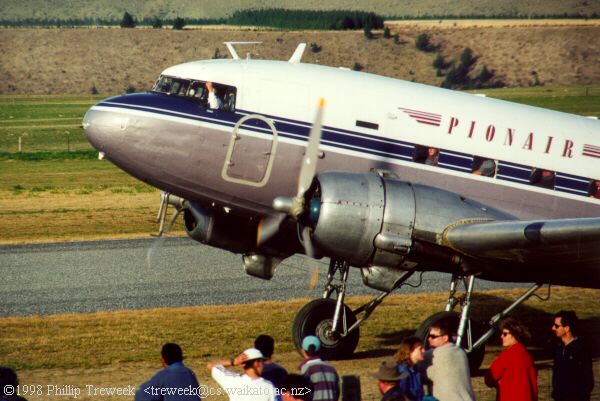
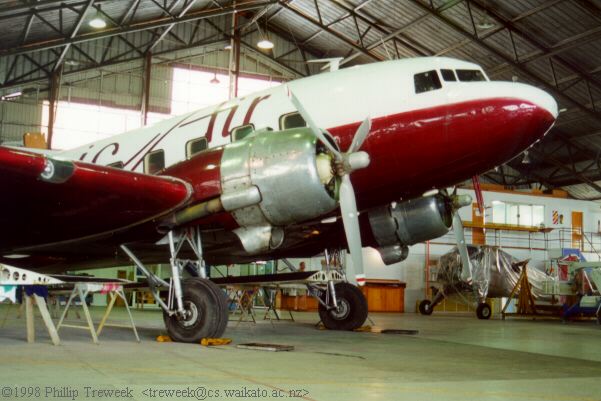
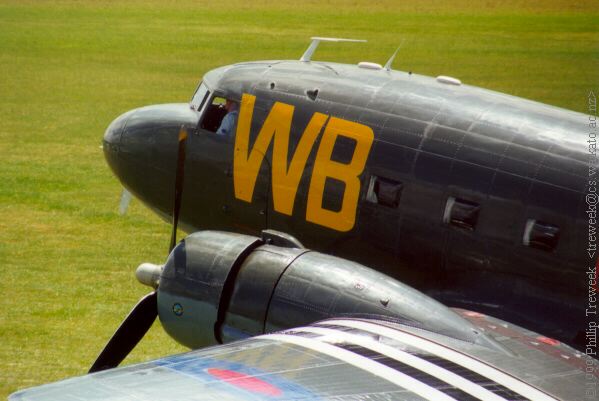
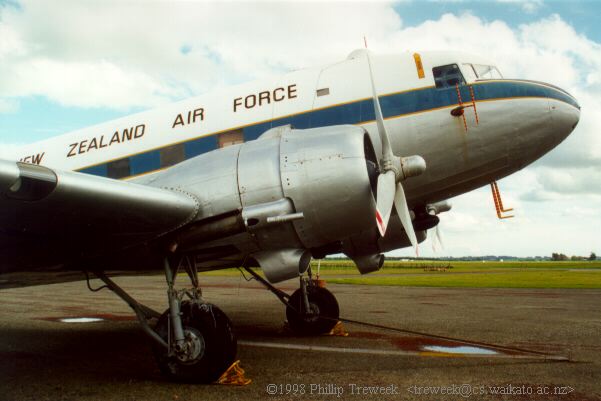
And one with normal setup to show difference...
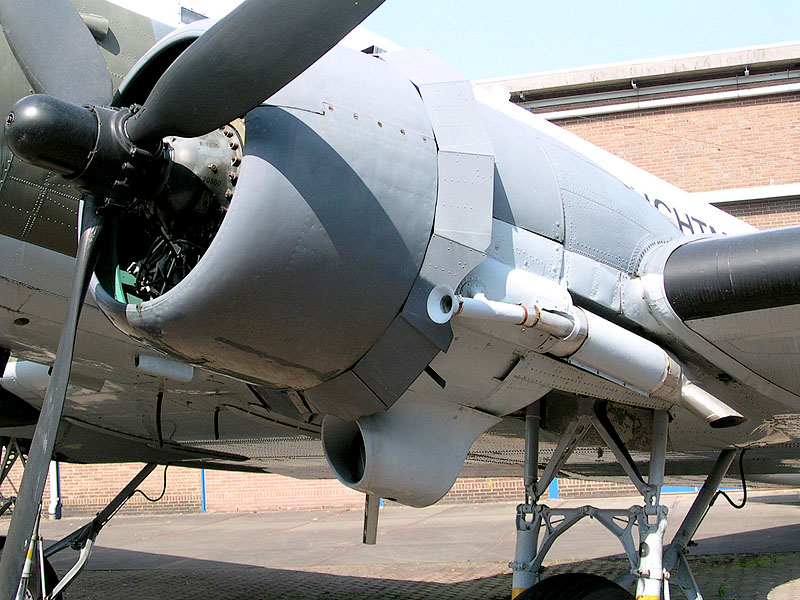
All the military DC3s and C47s that I flew (Rhodesia/Zimbabwe) had the hydraulically operated cowl flaps. Our aircraft had P&W R1830-90D and 92 engines, IIRC.
The mechanical part of the hydro-mechanical operating system was a bit prone to not working as it should. If you had CHT problems then use of the mixture controllers helped, but cost you fuel of course.
The mechanical part of the hydro-mechanical operating system was a bit prone to not working as it should. If you had CHT problems then use of the mixture controllers helped, but cost you fuel of course.
Aviator Extraordinaire
Join Date: May 2000
Location: Oklahoma City, Oklahoma USA
Age: 76
Posts: 2,394
Likes: 0
Received 0 Likes
on
0 Posts
On our DC-3 the cowl flaps had been modified. The upper cowl flaps had been removed and replaced with a fixed metal strip that had holes for cooling. The bottom cowl flaps operated the same as unmodified DC-3s.
As stated previously the three positions were/are Open-Trail-Closed. We used open for takeoff, trail for climb and closed in cruise.
I don't know if you can tell from this photo of my DC-3 or not.
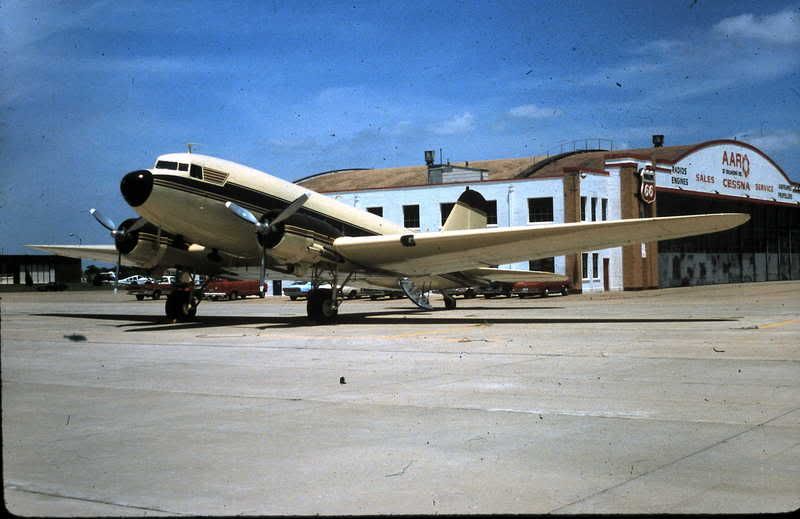
As stated previously the three positions were/are Open-Trail-Closed. We used open for takeoff, trail for climb and closed in cruise.
I don't know if you can tell from this photo of my DC-3 or not.

Last edited by con-pilot; 19th Nov 2009 at 21:54.
I stand to be corrected here, but I think it had something to do with converting DC3s and C47s back to Australian civilian use after WW2.
The DC3 first operated in Australia in 1937 or 38 and it was similar, but not identical, to the military C47. The DC3 was originally powered by a pair of single row Wright 1820 Cyclones. I think they were about 1000 HP.
Airline service was interrupted by the war when the US military impressed civilian DC3s into service and took over the production run, with C47 and other military variants, of the type. Compared to the DC3 the C47 had a stronger floor, different passenger door, a large parachute door and was powered by P&W 1830s of 1200HP.
When the war ended military DC3s and variants were returned to civilian use. In Australia a bunch of them were bought by ANA and TAA and they were all converted to a common engine configuration - P&W R1830s with fixed cowls.
Thats how I remember it being explained to me, in the 80s, by an Ancient Pelican who knew this sort of stuff. There are are a few in D&G who will correct me if needed
Cheers!
Pithblot
The DC3 first operated in Australia in 1937 or 38 and it was similar, but not identical, to the military C47. The DC3 was originally powered by a pair of single row Wright 1820 Cyclones. I think they were about 1000 HP.
Airline service was interrupted by the war when the US military impressed civilian DC3s into service and took over the production run, with C47 and other military variants, of the type. Compared to the DC3 the C47 had a stronger floor, different passenger door, a large parachute door and was powered by P&W 1830s of 1200HP.
When the war ended military DC3s and variants were returned to civilian use. In Australia a bunch of them were bought by ANA and TAA and they were all converted to a common engine configuration - P&W R1830s with fixed cowls.
Thats how I remember it being explained to me, in the 80s, by an Ancient Pelican who knew this sort of stuff. There are are a few in D&G who will correct me if needed

Cheers!
Pithblot
Last edited by pithblot; 20th Nov 2009 at 00:51. Reason: Punk-chew-a-Shun
The hydraulically operated cowl flaps were more useful in very cold conditions, when they could be closed off to keep CHTs up. One of the big no-nos with those 1830s was letting them get too cold on descent.
In warmer climes hydraulic cowl flaps provided no advantage over the simple fixed cowl opening and is probably why operators modified to the lighter and trouble-free alternative. As far as climb and cruise performance went, the differences were minimal.
In warmer climes hydraulic cowl flaps provided no advantage over the simple fixed cowl opening and is probably why operators modified to the lighter and trouble-free alternative. As far as climb and cruise performance went, the differences were minimal.
Join Date: Jun 2004
Location: Australia
Posts: 1,843
Likes: 0
Received 0 Likes
on
0 Posts
All of the DC3s that I flew (P&W R-1830s) had fixed cowls, it was explained to me as a young sprog that -
(1) The variable cowl flap system was unreliable, erratic, and required a lot of maintainance, and
(2) Unnecessary in the Temperate / Tropical conditions in which we operated, with the fixed 'optimised' setting.
The latter was true, we rarely had any CHT problems. Only once did I ever see the use of 'Auto Rich' necessary during cruise, and 6 or 7 times had to resort to 'Emergency Rich' during prolonged climb at high power to 16,000 feet or so to avoid the New Guinea hills. In both cases, use of the Mixture control worked well, and kept the CHTs within limits.
We were obsessive in the use of 'balanced power' (not much less than Holding Power) during descent, and never had any problems with low CHT.
The only twitchy part of the engine controls was the Carby Heat, with only a small tweak of the control resulting in large variations in intake temperature.
Regards,
Old Smokey
(1) The variable cowl flap system was unreliable, erratic, and required a lot of maintainance, and
(2) Unnecessary in the Temperate / Tropical conditions in which we operated, with the fixed 'optimised' setting.
The latter was true, we rarely had any CHT problems. Only once did I ever see the use of 'Auto Rich' necessary during cruise, and 6 or 7 times had to resort to 'Emergency Rich' during prolonged climb at high power to 16,000 feet or so to avoid the New Guinea hills. In both cases, use of the Mixture control worked well, and kept the CHTs within limits.
We were obsessive in the use of 'balanced power' (not much less than Holding Power) during descent, and never had any problems with low CHT.
The only twitchy part of the engine controls was the Carby Heat, with only a small tweak of the control resulting in large variations in intake temperature.
Regards,
Old Smokey
It always amazed me that in Australia in the Fifties the airlines removed the rubber de-icing boots from the empennage of DC3's and forced crews to fly in icing conditions. The danger area was the flight to Tasmania where in winter aircraft often got iced up.
The fact was the DC3 with no de-icing boots was not legally equipped to fly in known icing conditions. Perhaps the crews worked on the premise that weather forecasting is not an exact science and the met people could only give professional advice. Pilots could take it or leave it. Those that elected not to fly because of risk of icing found their jobs in jeopardy if they tried that caper too many times.
Regardless of the commercial cost because of the additional weight of the empennage de-icing systems, it became an established practice to ignore the risks involved and blast off into icing weather. Happens all the time even now with cargo light twins doing the night runs between cities in mid winter. Few aircraft came to grief but there were some awfully close shaves. In those days, the adage that "get away with anything long enough, and the perceived risks diminishes" applied one hundred percent to those Australian operators who knowingly risked passengers lives. Department of Civil Aviation inspectors who were in awe of the airline managements run by hard nosed managers simply looked the other way.
To it's credit, the RAAF never considered removing the de-icing boots on Dakota aircraft as they knew that airframe icing was inevitable in some parts of Australia and in CB cloud formations.
The fact was the DC3 with no de-icing boots was not legally equipped to fly in known icing conditions. Perhaps the crews worked on the premise that weather forecasting is not an exact science and the met people could only give professional advice. Pilots could take it or leave it. Those that elected not to fly because of risk of icing found their jobs in jeopardy if they tried that caper too many times.
Regardless of the commercial cost because of the additional weight of the empennage de-icing systems, it became an established practice to ignore the risks involved and blast off into icing weather. Happens all the time even now with cargo light twins doing the night runs between cities in mid winter. Few aircraft came to grief but there were some awfully close shaves. In those days, the adage that "get away with anything long enough, and the perceived risks diminishes" applied one hundred percent to those Australian operators who knowingly risked passengers lives. Department of Civil Aviation inspectors who were in awe of the airline managements run by hard nosed managers simply looked the other way.
To it's credit, the RAAF never considered removing the de-icing boots on Dakota aircraft as they knew that airframe icing was inevitable in some parts of Australia and in CB cloud formations.
Join Date: Dec 2005
Location: Wherever my visa lets me
Posts: 38
Likes: 0
Received 0 Likes
on
0 Posts
Gents,
It is a modification, incidentally never approved by Douglas or P&W. It works well though .
.
The fixed gill modifications are only approved in South Africa, Australia and New Zealand. I have done these conversions to fixed gills and from, ad nauseum. It's quite simple to unbolt the gill assembly and then manufacture 3 fixed sections, fixed at 11 degrees and then rivet them on. There is a cut out on the outboard side to fit around the bulge on the heater inlet cowling and either another cut out at the top to allow the top cowling to fit around the carb air scoops (only when using the ram/non-ram "saddle" airscoops), or a slight extension for the short carb airscoops, so cowl can fit snugly. Some fixed gill conversions have the heater cowling cut out on both sides, so that the cowlings can be interchangeable between left and right engines, and some have little holes in the gills, so that the accessory bay cowlings can be got at without too much stress.
The hydraulic lines are simply blanked with pressure blanks at the firewall and ditto for the selectors in the cockpit. Sometimes, we leave the selectors in the cockpit for show, some owners like this. In practice with the fixed gills in South Africa, we normally get a perfect cruise CHT of 200 deg. In cold conditions, this obviously drops, and in winter conditions cruise CHT can go as low as 160 deg, although this rare and the tendency is pretty much there with the normal gills too. As Old Smokey said, judicious use of "emergency rich" usually brings any high temp issues back into the green, but I've only ever experienced this once. This is bearing in mind that Take-Off CHT is permitted to go as high as 262 deg and cruise is permitted go as high as 232 deg.
It is true that the adjustments on the normal gills can be tedious and they can be a real pig to get aligned as the Maintenance Manual says, but once ok they work alright, just need looking at every check.
It is a modification, incidentally never approved by Douglas or P&W. It works well though
 .
.The fixed gill modifications are only approved in South Africa, Australia and New Zealand. I have done these conversions to fixed gills and from, ad nauseum. It's quite simple to unbolt the gill assembly and then manufacture 3 fixed sections, fixed at 11 degrees and then rivet them on. There is a cut out on the outboard side to fit around the bulge on the heater inlet cowling and either another cut out at the top to allow the top cowling to fit around the carb air scoops (only when using the ram/non-ram "saddle" airscoops), or a slight extension for the short carb airscoops, so cowl can fit snugly. Some fixed gill conversions have the heater cowling cut out on both sides, so that the cowlings can be interchangeable between left and right engines, and some have little holes in the gills, so that the accessory bay cowlings can be got at without too much stress.
The hydraulic lines are simply blanked with pressure blanks at the firewall and ditto for the selectors in the cockpit. Sometimes, we leave the selectors in the cockpit for show, some owners like this. In practice with the fixed gills in South Africa, we normally get a perfect cruise CHT of 200 deg. In cold conditions, this obviously drops, and in winter conditions cruise CHT can go as low as 160 deg, although this rare and the tendency is pretty much there with the normal gills too. As Old Smokey said, judicious use of "emergency rich" usually brings any high temp issues back into the green, but I've only ever experienced this once. This is bearing in mind that Take-Off CHT is permitted to go as high as 262 deg and cruise is permitted go as high as 232 deg.
It is true that the adjustments on the normal gills can be tedious and they can be a real pig to get aligned as the Maintenance Manual says, but once ok they work alright, just need looking at every check.
Bring back the Dak!
Join Date: Oct 2004
Location: UK
Posts: 85
Likes: 0
Received 0 Likes
on
0 Posts
All our UK Daks had adjustable gills, and I agree with all before, but being able to fully-close a well-adjusted set of gills on a failed engine was reassuring if not immediately noticeable, drag-wise!
As an amusing aside, we fitted a brand new pair of cowlings, (with gills), to an aircraft on check, and on it's single-engine climb tests afterwards, the rate of climb would start off well enough, but slowly decrease to the extent that the dead engine would have to be restarted to maintain height, and this happened on EITHER engine, at low weights!
Needless to say, as test-pilot I was much perplexed, as were the rest of the maint.personnel. No end of engine checking and fettling would improve matters; it failed the tests dismally.
I called down our Chief Pilot, and he found the same. During one of these attempts, I sat in the passenger cabin looking out at the labouring engine giving it's all, and I had an eureka moment. The new cowlings had come with nice tight gill linkages, but the space at the top immediately below our short air intakes was just an open space, about 17cm x 9cm. As the engine warmed up during the clinb, all the hot air was being fed up into this space to be sucked straight into the air intake, thus diminishing the engine's performance. A dash forward to ask the C/P to land asap, a piece of ally, some tin-snips and some rivets, with the new panel feeding right in flush below the intakes, saw the next tests done with climb to spare! We had been struggling with that aircraft for five wretched days!
You never stopped learning with a Dak. Happy days!
As an amusing aside, we fitted a brand new pair of cowlings, (with gills), to an aircraft on check, and on it's single-engine climb tests afterwards, the rate of climb would start off well enough, but slowly decrease to the extent that the dead engine would have to be restarted to maintain height, and this happened on EITHER engine, at low weights!
Needless to say, as test-pilot I was much perplexed, as were the rest of the maint.personnel. No end of engine checking and fettling would improve matters; it failed the tests dismally.
I called down our Chief Pilot, and he found the same. During one of these attempts, I sat in the passenger cabin looking out at the labouring engine giving it's all, and I had an eureka moment. The new cowlings had come with nice tight gill linkages, but the space at the top immediately below our short air intakes was just an open space, about 17cm x 9cm. As the engine warmed up during the clinb, all the hot air was being fed up into this space to be sucked straight into the air intake, thus diminishing the engine's performance. A dash forward to ask the C/P to land asap, a piece of ally, some tin-snips and some rivets, with the new panel feeding right in flush below the intakes, saw the next tests done with climb to spare! We had been struggling with that aircraft for five wretched days!
You never stopped learning with a Dak. Happy days!




